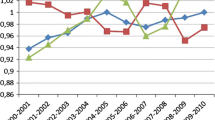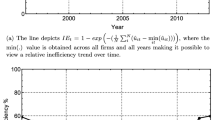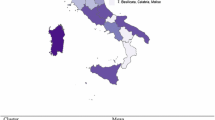Abstract
We investigate the evolution of efficiency and productivity in the hospital sector of an Austrian province for the time period 1994–1996. We use panel data to design non-parametric frontier models (Data Envelopment Analysis) and compare efficiency scores and time patterns of efficiency across medical fields. As health outcomes hardly can be measured in a direct way we make use of two different approaches for output measurement: In a first approach, we employ the number of case mix-adjusted discharges and of inpatient days, in a second we use credit points, which are calculated in course of the newly introduced diagnosis related group-type financing system. We calculate and compare individual efficiency scores for hospital wards as decision making units (DMU) in specified medical fields. To our knowledge the calculation of ward-specific efficiency scores has not up till now been the unit of non-parametric efficiency analysis. Our two models find different results: Model 1 with conservative output measurement calculates an average efficiency level of 96%, while model 2 with credit points for output measurement puts average efficiency at 70%. Whereas average efficiency in model 1 hardly changes and in model 2 increases modestly in the period 1994–1996, a closer look at single hospitals displays a variety of different efficiency developments over time.
Similar content being viewed by others
References
T. Andersen and N.C. Petersen, A procedure for ranking efficient units in data envelopment analysis, Management Science 39 (1993) 1261-1264.
BMAGS (Ministry of Labour, Health and Social Affairs), several years, Diagnosen-und Leistungsstatistik.
BMAGS (Ministry of Labour, Health and Social Affairs), several years, Kostenstellenstatistik.
C.L. Bryce, J.B. Engberg and D.R. Wholey, Comparing the agreement among alternative models in evaluating HMO efficiency, Health Services Research 35(2) (2000) 509-528.
J.F. Burgess and P.W. Wilson, Hospital ownership and technical ineffi-ciency, Management Science 42(1) (1996) 110-123.
T.N. Chirikos and A.M. Sear, Measuring hospital efficiency: A comparison of two approaches, Health Services Research 34(6) (2000) 1389-1408.
A. Dor and A.E. Farley, Payment source and the cost of hospital care: Evidence from a multi-product cost function with multiple payer, Journal of Health Economics 15 (1996) 1-21.
M.M. Hofmarcher and H. Rack, eds., HiT Austria (Health Care Systems in Transition), European Observatory on Health Care Systems (2001), http://www.observatory.dk
B. Felderer et al., Produktivitätsveränderung in den Krankenanstalten in Kärnten, Projektbericht, Institute for Advanced Studies, Vienna (1999).
F. Førsund, The rise and fall of slacks: Comments on quasi-malmquist productivity indices, Journal of Productivity Analysis 10 (1988) 21-34.
Health Care Financing Administration, http://www.hcfa.gov/stats/ indicatr.htm
M.M. Hofmarcher and M. Riedel, Utilization of resources in the EU: 3:1 for the hospital sector. Focus: Development of productivity in the Austrian hospital sector, Health System Watch 2 (2000), http://www. ihs.ac.at
K. Lauterbach and M. Arnold, Über die Vor-und Nachteile einer leistungsbezogenen Vergütung der stationären Versorgung, Lehren aus den USA für das deutsche Krankenhaus, in: Krankenhaus-Report '95, ed. A. Paffrath (Gustav Fischer Verlag, 1995) pp. 167-175.
M. Linna, Measuring hospital cost efficiency with panel data models, Health Economics 7 (1998) 415-427.
J. Magnussen, Efficiency measurement and the operationalization of hospital production, Health Services Research 31(1) (1996) 21-37.
Österreichischer Rechnungshof, Wahrnehmungsbericht des Rechnungshofes betreffend Reform des Gesundheitswesens und Krankenanstaltenfinanzierung, LKF, Niederösterreichischer Gesundheits-und Sozial-Fonds (Niederösterreich 2000/10), Vorlage vom 28 (Juli 2000).
Österreichischer Rechnungshof, Wahrnehmungsbericht des Rechnungshofes betreffend Reform des Gesundheitswesens und Krankenanstaltenfinanzierung, LKF, Tiroler Krankenanstaltenfinanzierungsfonds (Tirol 2000/3), Vorlage vom 28 (Juli 2000).
M.S. Rauner and M.-M. Schaffhauser-Linzatti, Evaluation of the new Austrian inpatient reimbursement system, in: Monitoring, Evaluating, Planning Health Services, eds. V. De Angelis, N. Ricciardi and G. Storchi (World Scientific, Singapore, 1999) pp. 221-233.
SAKRAF, Bericht über den Salzburger Krankenanstaltenfinanzierungsfonds (SAKRAF) betreffend das Jahr 1999, Salzburg (2000).
M. Sommersguter-Reichmann, The impact of the Austrian hospital fi-nancing reform on hospital productivity, Empirical evidence on ef-ficiency and technology changes using a non-parametric input-based Malmquist approach, Health Care Management Science 3 (2000) 309-321.
A. Stepan and M. Sommersguter-Reichmann, Analyse des neuen Leistungsorientierten Krankenanstalten-Finanzierungssystems in Österreich, Arbeitspapier, Technische Universität Wien/Universität Graz (2001).
M. Tambour and C. Rehnberg, Internal markets and performance in Swedish health care, Working Paper Series in Economics and Finance, no. 161, Stockholm (1997).
M. Tambour, The impact of health care policy initiatives on productivity, Health Economics 6 (1997) 57-70.
V. Valdmanis, Sensitivity analysis for DEA models, Journal of Public Economics 47 (1992) 185-205.
Author information
Authors and Affiliations
Corresponding author
Rights and permissions
About this article
Cite this article
Hofmarcher, M.M., Paterson, I. & Riedel, M. Measuring Hospital Efficiency in Austria – A DEA Approach. Health Care Management Science 5, 7–14 (2002). https://doi.org/10.1023/A:1013292801100
Issue Date:
DOI: https://doi.org/10.1023/A:1013292801100




